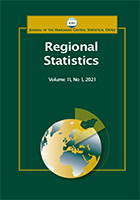Spatiotemporal inequalities of excess mortality in Europe during the first two years of the Covid-19 pandemic
Spatiotemporal inequalities of excess mortality in Europe during the first two years of the Covid-19 pandemic
Author(s): András IgariSubject(s): Social Sciences, Economy, Geography, Regional studies
Published by: Központi Statisztikai Hivatal
Keywords: Covid-19; excess mortality; pandemic geography; health inequalities; Europe
Summary/Abstract: The coronavirus pandemic has severely affected Europe, but not equally. The aims of this study were to present the methodological issues of using pandemic indicators and to analyse the regional excess mortality data to show which regions and countries in Europe were the most and least affected by Covid-19 in each period of the pandemic, with a particular focus on the geographical reasons behind the differences. The study found that there were significant spatial inequalities and a strong centre-periphery differences in the excess mortality in Europe Although the centres (metropolitan and urban regions, Western and Southern Europe) were the most affected during the first wave, from the second wave, the main negative effects of the pandemic were shifted to the peripheries: rural regions and East-Central Europe (especially Bulgaria). However, the geographically isolated peripheries (sparsely populated areas and islands) had low excess mortality throughout the entire period.
Journal: Regional Statistics
- Issue Year: 13/2023
- Issue No: 03
- Page Range: 510-535
- Page Count: 26
- Language: English

